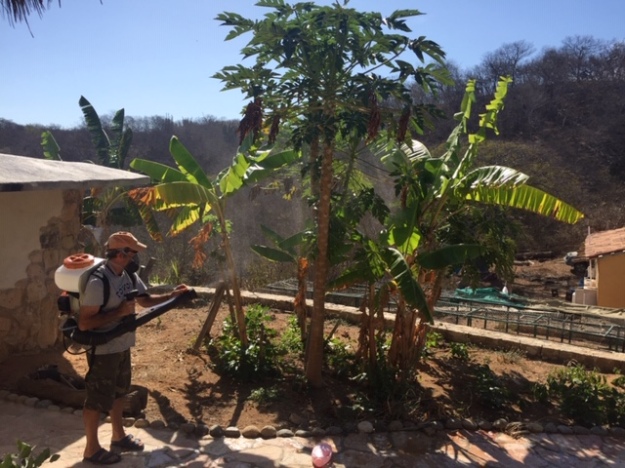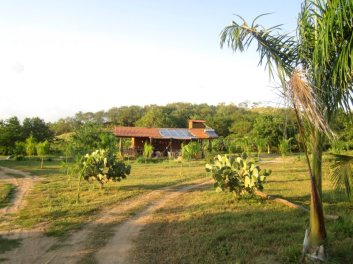Thoughts on the pursuit of living sustainably SOB (south of the border), plus a vetted listing of cultural, environmental, and educational programs where you can actively give back to the environment and local communities that you visit while in Mexico!

Do you want to make your trip to Mexico truly memorable and one of meaning? Do you want to contribute to real sustainability while having fun and seeing the country? If so, then this post is for you!
The following is a listing of places where your touring dollar or volunteering efforts can really make a difference. These listings are not typical eco-tourist destinations operating loosely under the guise of being “green” or culturally beneficial. Rather, these sites all have proactive environmental sustainability, education, or relief services as core aspects of their operating mission. These organizations have been individually selected and vetted as places where you can enhance your experience of mexico by actively participating in legitimate projects that really do provide a benefit to the planet.
Please note that many of these locations are working organic farms, ranches, research field stations, schools, etc. and, as such, take volunteers or other visitors on an advanced approval basis only. Unless noted, please be sure to contact the site ahead to make any necessary arrangements for your visit.
I hope that you’ll comment on your experiences, and suggest your own secret spots for helping to have (our) touring dollars & volunteering efforts make a positive difference! This list will be updated frequently and your suggestions will be added. Please provide links, or any other contact info in the comments section (click on comments bubble above).
Bien Viaje! Enjoy the tour!

Pacific Coast
Nearest City: Tepic / Sayulita
Type of Visit: school + center for preservation of indigenous peoples (Huichol) / volunteer work exchange (2 month min. + spanish). Advance arrangements suggested
Name: The Huichol Center for Cultural Survival
website/ http://www.thehuicholcenter.org/about-us/
contact info: Susana Valadez huicholcenter@juno.com
****************
State: Jalisco (El Tuito)
Nearest City: Puerto Vallarta
Type of Visit: eco tourism + education / extensive tropical gardens & organic restaurant. No advance booking required.
Name: Vallarta Botanical Gardens
website: http://www.vbgardens.org
contact info: info@vbgardens.org
From within Mexico: 322-223-6182 From outside of Mexico: 011-52-322-223-6182
****************
State: Jalisco (Mayto)
Nearest City: Puerto Vallarta / El Tuito
Type of Visit: working organic ranch + campground / guided horse, botanical and educational tours / volunteer work exchange programs (10 day min. – by application) + longer internships & homesteading options
Name: Rancho Sol y Mar
website/ www.ranchosolymar.com
contact info: ranchosolymar@gmail.com
****************
State: Jalisco (Mayto)
Nearest City: Puerto Vallarta / El Tuito
Type of Visit: Turtle Research Camp / nightly turtle releases in season (no advance booking required). Volunteer work exchange programs (contact for further info)
Name: Campamento de Tortugas
website: http://www.facebook.com/campamentomayto
contact info: israel_llamas@hotmail.com
****************
State/Region: Jalisco / Lake Chapala
Nearest City: Chapala
Type of Visit: eco farm + education + community development / volunteer work exchange
Name: Acá Centro Ecológico
Website: www.greatgreens.org
Contact Info: Mari Prudent marimexico@gmail.com

Baja Peninsula (California Sur)
State: Baja (Cal Sur)
Nearest City: Cabo San Lucas
Type of Visit: eco tourism / working organic farm / eco visit or volunteer work exchange
Name: Rancho La Venta
Website: http://www.rancholaventa.com/RanchoLaVenta/Home.html
Contact info: rancholaventa1@me.com
****************
State: Baja
Nearest City: San Jose Del Cabo
Type of Visit: wellness / creative arts center + organic farm + CSA / volunteer work exchange
Name: La Semilla / Raices y Brasos
Website: http://raicesybrazos.com/la-semilla/
Contact: local #: (624) 142-3794 US #: (802) 734-9808
****************
State/Region: Baja
Nearest City: Tiajuana
Type of Visit: Cattle Ranch being converted to organic farm / volunteer work exchange
Name: El Papalote
Contact Info: 52+661-100-0000 (land) 52-1-664-194-7514 (cell)
****************
State/Region: Baja California Sur
Nearest City: La Ribera
Type of Visit: botanical gardens / teaching center / volunteer work exchange
Name: Buena Fortuna Jardin Botanico
Website (blog) http://buenafortunapermaculture.wordpress.com
Contact Info: seeds.forever@gmail.com

Central + South Central Highlands
State: Guanajuato
Nearest City: San Miquel de Allende
Type of Visit: center for sustainability & appropriate technology workshops (contact for workshop schedules)
Name: iCATIS Mexico / Instituto Tierra y Cal
Website: http://www.icatis.org/catis-mexico
Contact info: Dylan Terrell dylan@icatis.org
****************
State: Oaxaca
Nearest City: Oaxaca
Type of Visit: off grid living / volunteer in exchange for learning about solar, chickens bee keeping, and grey water
Name: Sn Fco Lachigoló
Contact info: Daniel Ellsworth 52-1-951-142-1849
****************
State/Region: Oaxaca
Nearest City: Oaxaca
Type of Visit: urban / relief work with children, primarily education. No advance necessary.
Name: Oaxaca Streetchildren Grassroots
Website/Contact Info: http://www.oaxacastreetchildrengrassroots.org yjimenez@oaxacastreetchildrengrassroots.org
****************
State/Region: Oaxaca
Nearest City(Guevea de Humboldt)
Type of Visit: organic coffee plantation / volunteer work exchange
Name: Linda Vista / ConDoy Coffee Farm
Website (blog): http://condoycafe.wordpress.com
****************
State/Region: Michoacan (Lake Pátzcuaro)
Nearest City: Pátzcuaro
Type of Visit: organic permaculture farm / retreat center / volunteer work exchange (2 wk. min.
Name: Bosque Village
Website/Contact info: bosquevillage@gmail.com
****************
State: Mexico
Nearest City: Malinalco / Tenancingo / Mexico City (D.F.)
Type of Visit: organic farm, school & retreat center / volunteer work exchange
Name: Rancho Cazahuate
website: www.centronierika.net
Contact Info: Anya Loizaga Velder www.ecomundi.info or
****************
State: Chiapas (Teopisca)
Nearest City: San Cristóbal de Las Casas
Type of Visit: non-profit farm & community development / volunteer work exchange (1 month min.)
Name: El Porvenir
Website/Contact info: 52+9671107386  / 52+1+ 9671149914(cell)
/ 52+1+ 9671149914(cell)
****************
State/Region: Morelos
Nearest City: Amatlan
Type of Visit: Yoga/Healing Center
Name: Garden of Eden Healing Community
Website/Contact Info: http://www.moving-overseas-guide.com/2012-awakening.html

Yucatan Peninsula + Chiapas
State: Quintana Roo (Tulum)
Nearest City: Cancun / Playa Del Carmen
Type of Visit: Eco tourism, biological reserve park & lodging. Nature Tours. Reservations suggested.
Name: Sian Ka’an Bio Reserva
Website/Contact info: (http://www.visitsiankaan.com)
****************
State: Quintanaroo
Nearest City: Playa Del Carmen
Type of Visit: Working organic farm / volunteer work exchange, 2 wk min.
Name: Tumbem Ha
Website: http://www.tumbenha.com(http://www.facebook.com/TumbenHa)
Contact info: alexis@tumbenha.com
****************
State/Region: Yucatan
Nearest City: Vallodolid / Merida / Cancun
Type of Visit: Sustainability courses / volunteer work exchange (3 wk. min.)
Name: Lodgecol
Website: lodgecol.com
****************
State: Qintana Roo
Nearest City: Cancun
Type of Visit: Environmental & cultural educational tours offered (fee).
Name: Project Mayan Encounter
website: (http://accessecotours.com/tours_7.html)
****************
State/Region: Chiapas
Nearest City: San Cristóbal de Las Casas
Type of Visit: After school student center in indigenous Mayan Community.
Name: La Chozita / Chiapas Children’s Project
Website: http://www.lachozita.org/ourwork.html
****************
Contact Info: info@lachozita.org
State/Region: Chiapas
Nearest City: Teopisca
Type of Visit: Education, community development, environmental protection
Name: El Porvenir
Contact Info: 52+9671107386
****************
Nearest City: Playa Del Carmen
Type of Visit: rustic organic farm / volunteer work exchange
Name: Tumben Kuxtal
contact info: 52-1-998-133-4486

Gulf Coast
State: Veracruz
Nearest City: Xalapa
Type of Visit: aquaponics classes / urban organic farm / volunteer work exchange
Name: Semilla Verde
website/contact info: http://www.facebook.com/semilla.huertoshidroponicos

Northern States
State: Chihuahua
Nearest City: Juarez
Type of Visit: orphanage / volunteer work exchange
Name: Rancho Los Amigos
contact info: Patti Kidd ph: 407-232-3009
****************
State/Region: Nuevo Leon
Nearest City: Monterey
Type of Visit: Relief Work (distribution of food & clothing)
Name: Ammac
Website: http://www.ammac.com.mx/#!inicio/mainPage
Contact Info: Info@ammac.com.mx
****************
State/Region: Sonora
Nearest City: Puerto Penasco
Type of Visit: medical clinic staffing
Name: Manos de Ayuda
Website/Contact Info: webmaster@manosdeayuda.org U.S. (520) 760-8645

Pay-For Volunteer Programs
State: Various
Nearest City: N/A
Type of Visit: Pay-for volunteer programs (teaching, medical, schools, etc. – $270 U.S. per week to participate)
Name: International Volunteer HQ
website/contact info: International Volunteer Head Quarters (volunteerhq.org)
****************
S State: Various
Nearest City: N/A
Type of Visit: Pay-for volunteer programs (promote peace & justice, work with children – $2,295 U.S. per week to participate)
Name: Global Volunteers
website/contact info: (www.globalvolunteers.org)
****************
State: Nayarit & Jalisco
Nearest City: Puerto vallarta
Type of Visit: Pay-for conservation, cultural, and ecology-oriented “expeditions”.
Name: EcoTeach
website/contact info: http:
//www.ecoteach.com/announcing-new-opportunities-to-see-turtles-in-mexico/
****************
State: Various
Nearest City: N/A
Type of Visit: 72 listings for (mostly) pay-for volunteer service organizations operating in Mexico!
Name: GoAbroad
website/contact info: http://www.goabroad.com
****************
State/Region: Various
Nearest City: N/A
Type of Visit: Eco tours + some coordination with local NGO’s for more extensive volunteer / service options.
Name: Glocal Travel
Website/Contact Info: info@glocaltravel.net http://www.glocaltravel.net

Passive Eco Tourism Destinations
In researching this post I came across numerous quasi eco tourist establishments that adorn themselves with green labeling but have little if anything to offer in the way of active environmental or cultural payback. Following is a link to tourist resort properties that appear to be offering truly low impact, mostly sustainable amenities, even if they don’t offer opportunities for active service.
http://www.eco-tropicalresorts.com/centralamerica/mexico.htm




























